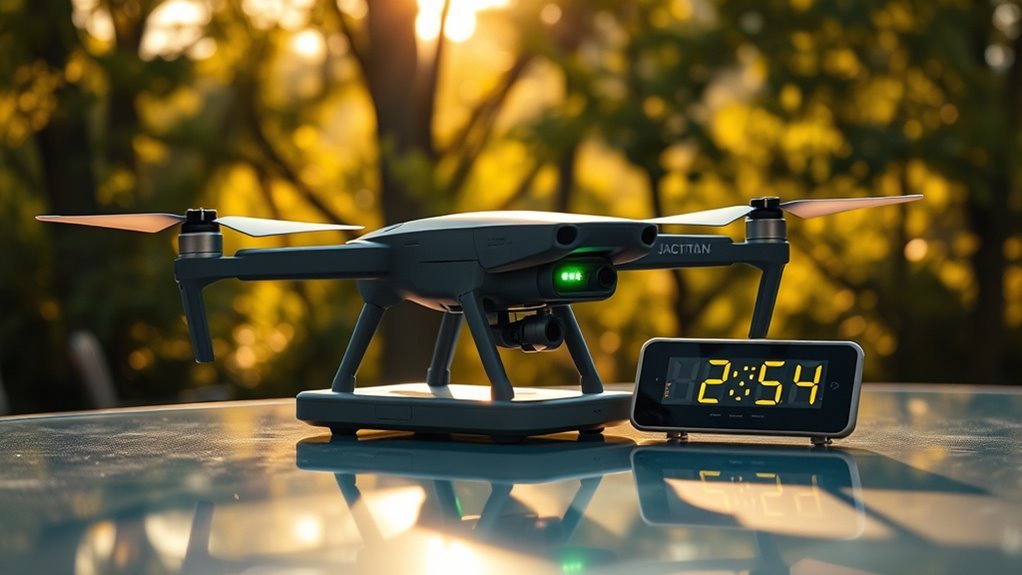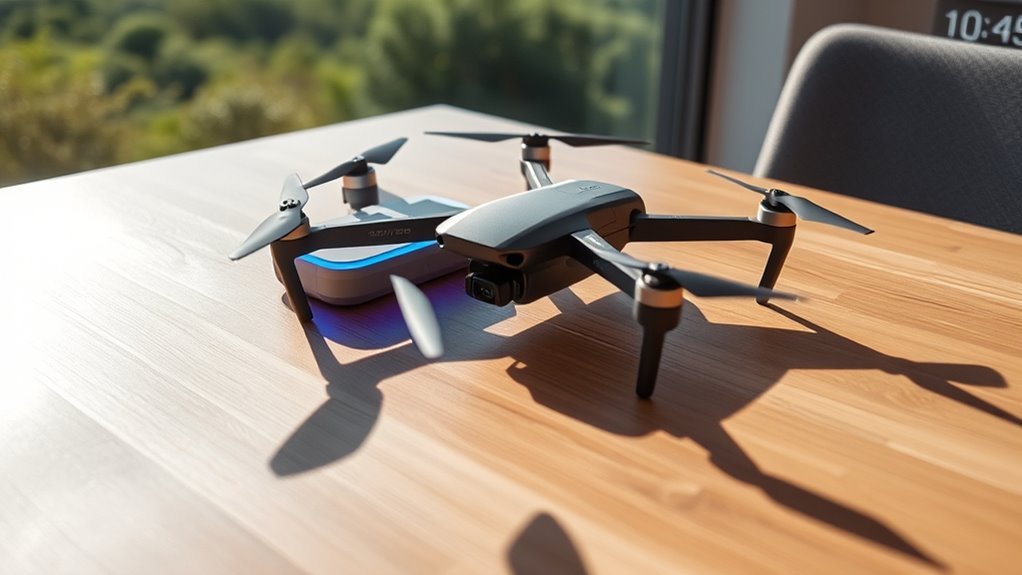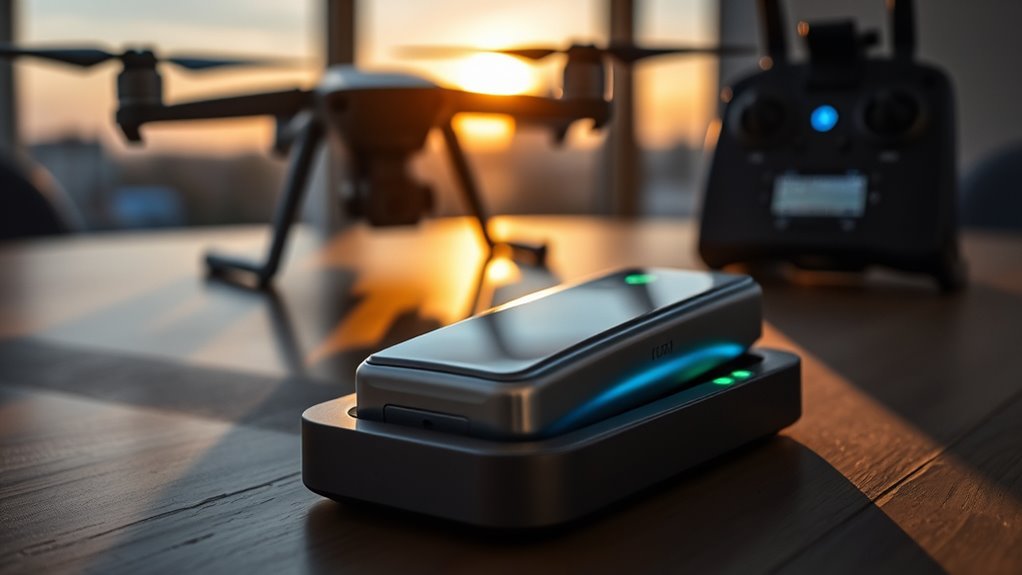Charging a drone battery usually takes between 30 minutes to over 90 minutes, depending on the battery type and drone model. High-performance racing drones with Lithium Polymer (LiPo) batteries often recharge in 30 to 60 minutes, while consumer drones may take 90 minutes or longer. Factors like charger output and ambient temperature also play roles in charging times. Learn more about optimizing charging and maintaining battery health to enhance your drone experience.
Understanding Drone Battery Types

When you’re diving into the world of drones, understanding the various battery types is essential for optimizing performance and flight time. The two most common types are lithium polymer (LiPo) and nickel metal hydride (NiMH). LiPo batteries are favored for their lightweight design and high energy density, allowing longer flight durations and rapid discharge rates. However, they require careful handling and specific charging protocols to avoid hazards. On the other hand, NiMH batteries are more robust and less sensitive to overcharging, providing a safer but heavier alternative. While they may offer shorter flight times, their durability can be appealing for casual users. Additionally, extended battery life performance enables users to explore without interruptions. Knowing the pros and cons of each type enables you to tailor your drone experience for maximum freedom in the skies. Additionally, advancements in battery technology are continually enhancing drone performance and extending flight times.
Charging Times for Different Drone Models

Understanding the differences in battery types leads to critical insights about charging times for various drone models. Different drone specifications dictate how quickly a battery can charge. For instance, high-performance racing drones equipped with lithium-polymer batteries often charge in 30 to 60 minutes, thanks to advanced battery technology. Conversely, consumer drones with larger batteries may take up to 90 minutes or more.
The charging time also varies based on the charger’s output power and the battery’s capacity. Understanding your drone’s specifications can help you choose the right charger, optimizing your charging experience. Ultimately, knowing these details allows you to plan flights more effectively and guarantees you’re ready for your next aerial adventure without unnecessary delays.
Factors Affecting Charging Time

Several factors influence how long it takes to charge a drone battery, including battery chemistry, charger specifications, and ambient temperature. The type of battery technology, such as LiPo or Li-ion, greatly impacts the charging speed. For example, LiPo batteries often charge faster than their Li-ion counterparts due to their inherent design. Additionally, the charger’s output—measured in amps—determines how quickly energy can flow into the battery. Higher amp ratings can lead to reduced charging times but may also risk overheating if not managed properly. Ambient temperature plays a critical role too; extreme cold or heat can hinder ideal charging performance, affecting overall efficiency. Understanding these factors helps you optimize your drone’s charging time and enhance your flying experience.
Standard Charging Methods
When considering standard charging methods for drone batteries, it’s essential to understand how charging time factors, types of chargers, and battery capacity impact overall performance. Each method affects the efficiency and duration of the charging process. You’ll find that selecting the right charger and understanding your battery’s specifications can markedly optimize your charging experience.
Charging Time Factors
Although the charging time for a drone battery can vary considerably, several key factors influence the duration required for completion when using standard charging methods. Understanding these factors can enhance your charging efficiency and overall experience. Here are three primary considerations:
- Battery Capacity: Larger batteries typically take longer to charge due to their increased energy storage.
- Charger Output: The wattage of your charger directly impacts charging speed; higher wattage equates to faster charging times.
- Battery Technology: Different battery chemistries (like LiPo vs. NiMH) exhibit varying charging characteristics, affecting overall duration.
Types of Chargers
While you may encounter various types of chargers for drone batteries, understanding the standard charging methods is essential for optimizing your charging experience. Smart chargers are a popular choice, as they adjust the charging current based on battery needs, ensuring safety and efficiency. These chargers often feature universal compatibility, allowing them to work with multiple battery types, which can be a game changer for users with various drones. Additionally, standard AC/DC chargers provide a straightforward approach, utilizing your wall outlet to recharge batteries. However, they may lack the advanced features of smart chargers. Ultimately, selecting the right charger will enhance your drone’s performance, prolong battery life, and give you the freedom to fly without unnecessary downtime.
Battery Capacity Impact
Understanding the impact of battery capacity on charging methods is essential for optimizing drone performance. The battery size directly influences charging time, especially with varying drone weights. Larger batteries typically take longer to charge, but they can provide extended flight times, enhancing your drone’s capabilities.
Factors to take into account include:
- Battery Size: Larger capacities require more time for a full charge.
- Drone Weight: Heavier drones often need larger batteries, affecting the overall efficiency.
- Charging Method: Standard chargers may vary in output, influencing how quickly your battery reaches full capacity.
Fast Charging Options
As drone technology evolves, the demand for faster charging options has become increasingly essential for both recreational and professional users. Fast charging technology employs advanced algorithms and higher power outputs to considerably reduce charging times. With rapid charging techniques, you can recharge your drone’s battery to 80% capacity in as little as 30 minutes, depending on the model. These methods utilize specialized chargers that manage heat and voltage, ensuring safety while maximizing efficiency. For those who value freedom in their drone usage, investing in fast charging solutions can mean less downtime and more flight time. Ultimately, understanding these options empowers you to choose the best setup that aligns with your operational needs and enhances your overall drone experience.
Battery Maintenance for Optimal Performance
To guarantee peak performance of your drone battery, it’s essential to establish a regular charging schedule that aligns with your usage patterns. Additionally, consider the storage conditions; extreme temperatures can greatly impact battery health. By following these guidelines and incorporating lifespan tips, you can maximize the efficiency and longevity of your drone battery. Regularly monitor battery optimization techniques to ensure your drone operates efficiently during flights.
Regular Charging Schedule
Establishing a regular charging schedule is crucial for maintaining your drone battery’s peak performance and longevity. By adhering to a consistent battery charging routine, you can greatly enhance your battery’s life cycle and efficiency. Consider the following aspects to refine your schedule frequency:
- Charge after each flight: This guarantees your battery remains topped off for your next adventure, avoiding deep discharges.
- Avoid overcharging: Disconnect your battery once it’s fully charged to prevent heat buildup, which can degrade performance.
- Monitor usage patterns: Adjust your schedule based on flight frequency and duration to maintain an excellent balance between performance and lifespan.
Storage Conditions Importance
Proper storage conditions are vital for preserving your drone battery’s performance and extending its lifespan. Maintaining an ideal storage temperature is important; ideally, you want to keep your battery between 20°C and 25°C (68°F to 77°F). Temperatures outside this range can accelerate degradation, leading to diminished capacity and increased risk of failure.
Humidity effects also play a significant role in battery health. Excessive moisture can corrode internal components, while extremely dry conditions may lead to static discharge issues. To mitigate these risks, store your batteries in a controlled environment, preferably in a protective case that limits exposure to both temperature fluctuations and humidity. By prioritizing these conditions, you’ll guarantee your drone battery remains reliable for your next flight.
Battery Lifespan Tips
While charging a drone battery might seem straightforward, understanding how to maintain it can greatly enhance its lifespan and performance. To optimize your battery’s longevity, consider these essential tips:
- Monitor Charging Habits: Always use the recommended charger and avoid overcharging to prevent damage.
- Store Properly: Keep your battery in a cool, dry place, and avoid extreme temperatures to prevent deterioration.
- Plan for Battery Replacement: Regularly assess your battery’s health and replace it when you notice significant performance drops.
Tips for Extending Battery Life
To maximize your drone’s battery lifespan, you’ll want to adopt several key practices that can greatly enhance performance. First, perform regular battery calibration; this guarantees accurate readings and ideal energy efficiency. By calibrating, you help your drone manage its power usage more effectively, prolonging battery life. Additionally, sophisticated algorithms adjust energy allocation based on payload weight and flight conditions, optimizing battery efficiency.
Additionally, avoid exposing your battery to extreme temperatures, as this can degrade its performance. Keeping your battery charged between 20-80% will also help maintain its health over time. Finally, consider using energy-efficient flight modes when possible. These adjustments not only extend your battery life but also enhance your flying experience. By applying these tips, you’ll enjoy longer flight times and greater freedom in your aerial adventures. Furthermore, understanding battery capacity is essential for predicting flight duration and managing your drone’s performance effectively.
Safety Precautions When Charging
When charging your drone battery, it is crucial to adhere to safety precautions to prevent accidents and guarantee peak performance. Implementing proper safety protocols guarantees a reliable charging environment. Here are a few key points to remember:
- Use the Manufacturer’s Charger: Always use the charger specifically designed for your drone battery to avoid overheating and damage.
- Monitor the Charging Area: Confirm the charging area is dry, well-ventilated, and free of flammable materials to minimize risks.
- Avoid Overcharging: Disconnect the battery once fully charged to prevent overheating and potential battery failure.
Monitoring Battery Health
After ensuring a safe charging environment, it’s important to monitor your drone battery’s health regularly. This involves tracking battery performance and understanding charge cycles to maximize longevity. Regular assessments can help you identify degradation patterns that could affect your flights. Additionally, knowing the flight time comparison between different drone models can help you choose the right battery management strategy. Understanding battery capacity is essential as it determines the overall range and flight time of your drone.
| Aspect | Importance |
|---|---|
| Charge Cycles | Determines lifespan |
| Voltage Levels | Indicates health status |
| Temperature | Affects performance |
| Cycle Count | Tracks usage over time |
| Discharge Rate | Impacts flight duration |
Planning Your Flights Around Charging Times
When planning your drone flights, understanding the various battery types and their charging times is essential. You’ll need to take into account your charging station options and how they align with your flight duration requirements. By strategically scheduling your flights around these factors, you can maximize your drone’s operational efficiency.
Battery Types Comparison
Understanding the differences between battery types is essential for planning your drone flights effectively, as each type varies considerably in charging times and performance.
When comparing lithium-ion and NiMH batteries, here are some key points to take into account:
- Lithium Advantages: They charge faster, offering a quick turnaround for flights, and generally have a longer lifespan.
- NiMH Disadvantages: These batteries take longer to charge and have a shorter life cycle, which can limit your flying time.
- Weight Considerations: Lithium batteries are lighter, improving flight efficiency, while NiMH batteries add extra weight, affecting overall performance.
Charging Station Options
Choosing the right charging station can greatly impact your drone’s operational efficiency, especially since charging times can vary greatly depending on the battery type and station capabilities. If you’re looking to maximize flight time and minimize downtime, consider integrating solar charging solutions into your setup. These stations harness renewable energy, allowing you to stay airborne longer without relying on conventional power sources. Additionally, portable chargers can provide the flexibility needed for extended flights in remote locations. They guarantee you can quickly recharge your batteries on the go, reducing the impact of charging times on your operational schedule. By strategically selecting charging options, you can enhance your drone’s performance and guarantee you’re always ready for your next flight adventure.
Flight Duration Planning
Maximizing your drone’s flight duration requires careful planning around battery charging times. To enhance your operational efficiency, consider these key strategies for battery optimization:
- Schedule your flights: Plan flights during peak battery performance, typically when batteries are at ideal charge levels.
- Monitor charging times: Understand how long it takes to charge your batteries fully and plan your activities accordingly.
- Utilize spare batteries: Keep additional charged batteries on hand to extend flight duration without downtime.
Frequently Asked Questions
Can I Use a Phone Charger to Charge My Drone Battery?
You can’t use just any phone charger for your drone battery. Different drone battery types require specific charging compatibility. Always check your drone’s specifications to guarantee safe and efficient charging to avoid potential damage.
What Happens if I Overcharge My Drone Battery?
If you overcharge your drone battery, it can lead to battery damage, reducing lifespan or causing overheating. Prioritizing charging safety is essential to maintain performance and guarantee safe operation during your flights.
Are There Universal Chargers for All Drone Batteries?
Oh, wouldn’t it be grand if one charger fit all? Unfortunately, charger compatibility varies with battery types. You’ll need to check specifications, or risk turning your drone dreams into a charging nightmare.
How Long Do Drone Batteries Typically Last?
Drone batteries typically last between 20 to 30 minutes, depending on battery performance factors like weight, usage conditions, and flight style. Understanding drone battery lifespan helps you optimize your flying experience and maximize your freedom in the skies.
Can I Fly My Drone While the Battery Is Charging?
While it might seem tempting to multitask, flying your drone during charging isn’t advisable. Prioritize drone safety; instead, follow charging tips and allow the battery to rejuvenate fully for peak performance in your next flight.

